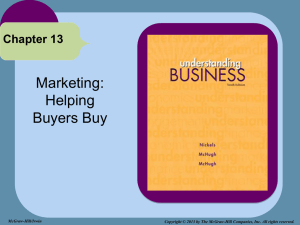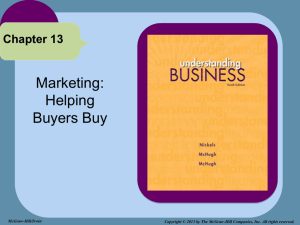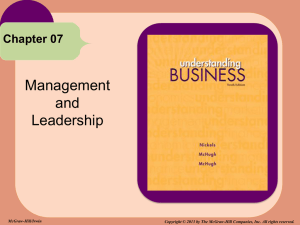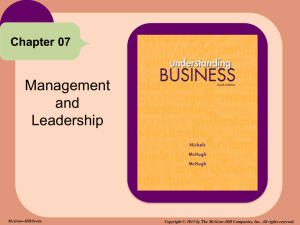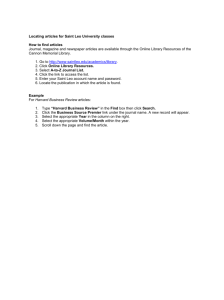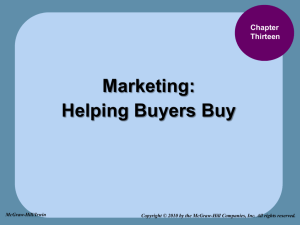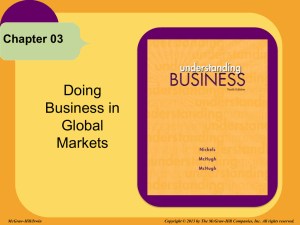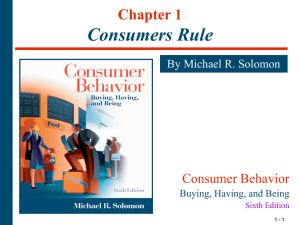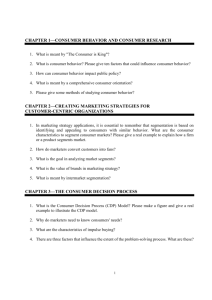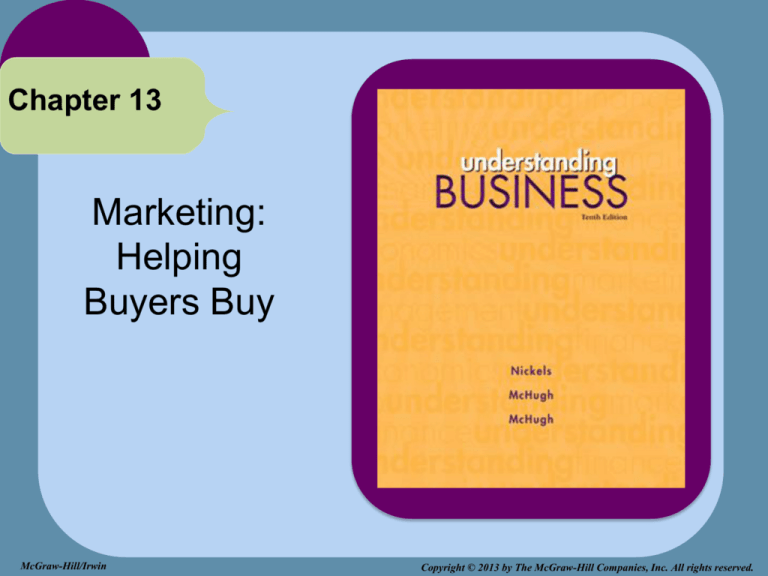
Chapter 13
Marketing:
Helping
Buyers Buy
McGraw-Hill/Irwin
Copyright © 2013 by The McGraw-Hill Companies, Inc. All rights reserved.
Chapter
Thirteen
LEARNING GOALS
1. Define marketing, and apply the marketing concept
to both for-profit and nonprofit organizations.
2. Describe the four P’s of marketing.
3. Summarize the marketing research process.
13-2
Chapter
Thirteen
LEARNING GOALS
4. Show how marketers use environmental scanning
to learn about the changing marketing
environment.
5. Explain how marketers apply the tools of market
segmentation, relationship marketing and the study
of consumer behavior.
6. Compare the business-to-business market and the
consumer market.
13-3
Profile
JOSEPH JIMENEZ
Novartis
• In 2010, Jimenez became
the first American CEO of
Swiss-based Novartis.
• Jimenez sees Novartis as
more than just a
pharmaceutical company.
• To exemplify marketing at its
best, social responsibility
needs to be part of the
Novartis mission.
13-4
Chapter
Thirteen
NAME that COMPANY
Where’s the beef? Many people don’t care about
the answer to that question anymore. As the
trend toward vegetarianism grows, this wellknown company in Canada offers a vegan
version of its chicken sandwich in 500 of its 750
stores.
Name that company!
13-5
What is
Marketing?
WHAT’S MARKETING?
LG1
• Marketing -- The activity, set of institutions and
processes for creating, communicating, delivering,
and exchanging offerings with value for customers,
clients, partners, and society at large.
13-6
What is
Marketing?
LG1
FOCUS of CONTEMPORARY
MARKETING
• Marketing today involves helping the buyer buy
through:
- Websites that help buyers find the best price,
identify product features, and question sellers.
- Blogs and social networking sites that cultivate
consumer relationships.
13-7
LET’S GO to the MOVIES
(Spotlight on Small Business)
• Many theaters provide food with movies.
• It may turn out that
such theaters only
appeal to a niche
market and may not
prove profitable.
• Do you have other
suggestions for how to
improve the moviegoing experience?
Photo Courtesy of: A.D. Wheeler
13-8
The Evolution
of Marketing
FOUR ERAS of U.S. MARKETING
LG1
• Production Era
• Selling Era
• Marketing Concept Era
• Customer Relationship
Era
13-9
The Evolution
of Marketing
LG1
The PRODUCTION and
SELLING ERAS
• The general philosophy
was “Produce what you
can because the market
is limitless.”
• After mass production,
the focus turned from
production to
persuasion.
13-10
The Evolution
of Marketing
The MARKETING CONCEPT ERA
LG1
• After WWII, a consumer spending boom
developed.
• Businesses knew they needed to be responsive
to consumers if they wanted their business.
13-11
The Evolution
of Marketing
LG1
APPLYING the
MARKETING CONCEPT
• The Marketing Concept includes three parts:
1. Customer Orientation -- Finding out what
customers want and then providing it.
2. Service Orientation -- Making sure everyone in
an organization is committed to customer
satisfaction.
3. Profit Orientation -- Focusing on the goods and
services that will earn the most profit.
13-12
The Evolution
of Marketing
LG1
The CUSTOMER
RELATIONSHIP ERA
• Customer Relationship Management (CRM) -Learning as much as you can about customers and
doing what you can to satisfy or exceed their
expectations.
• Organizations seek to enhance customer
satisfaction building long-term relationships.
• Today firms like Priceline and Travelocity use
CRM that allow customers to build a relationship
with the suppliers.
13-13
The Evolution
of Marketing
LG1
SERVICE with a SMILE
Six Steps for Keeping Your Customers Happy
• The cost of acquiring a new customer is 5x the
cost of retaining one. Here’s how to keep them:
1. Build trust
2. Emphasize the long term
3. Listen
4. Treat your customers like stars
5. Show appreciation
6. Remember employees are
customers too!
Source: Inc. Guidebook, Vol. 2 No. 5 and Entrepreneur, February 2010.
13-14
Nonprofit
Organizations
and Marketing
NONPROFIT MARKETING
LG1
• Nonprofit marketing tactics include:
- Fundraising
- Public Relations
- Special Campaigns
- Ecological practices
- Changing public opinions and
attitudes
- Increasing organizational
membership
13-15
Nonprofit
Organizations
and Marketing
LG1
MARKETING STRATEGIES for
NONPROFITS
• Nonprofit marketing strategies include:
- Determine the firm’s goals and objectives
- Focus on long-term marketing
- Find a competent board of directors
- Exercise strategic planning
- Train and develop long-term volunteers
- Carefully segment the target market
13-16
HOW GREEN is GREEN?
(Thinking Green)
• The clothing industry is
developing software to help
measure the environmental
impact of their apparel.
• Would you look at a label to
determine whether or not
you would buy tennis shoes
or a garment based on its
eco-friendliness?
13-17
The Marketing
Mix
The FOUR P’s
LG2
13-18
Designing a
Product to Meet
Consumer
Needs
DEVELOPING a PRODUCT
LG2
• Product -- A good, service, or idea that satisfies a
consumer’s want or need.
• Test Marketing -- Testing
product concepts among
potential product users.
• Brand Name -- A word,
letter, or a group of words
or letters that differentiates
one seller’s goods from a
competitor’s.
13-19
Setting an
Appropriate
Price
LG2
PRICING and
PLACING a PRODUCT
• Pricing products depends on many factors:
- Competitors’ prices
- Production costs
- Distribution
- High or low price strategies
• Middlemen are important in place strategies
because getting a product to consumers is
critical.
13-20
Developing an
Effective
Promotional
Strategy
PROMOTING the PRODUCT
LG2
• Promotion -- All the techniques sellers use to
inform people about their products and motivate them
to purchase those products.
• Promotion includes:
- Advertising
- Personal selling
- Public relations
- Word of mouth
- Sales promotions
Photo Courtesy of: Uri Baruchin
13-21
Developing an
Effective
Promotional
Strategy
LG1
PERFECT PROMOTION
How to Get Customers to Need Your Product
• Get customers emotional about your product:
- Make your product “built to love.”
- Use emotion-laden advertising.
• Be a likeable salesperson:
- Have confidence.
- Be intriguing.
- Show interest in others.
- Be enthusiastic and
respectful.
Sources: Entrepreneur, February 2011 and Entrepreneur, March 2010.
13-22
Developing an
Effective
Promotional
Strategy
TANGLED WEB of PROMOTION
Seven Sins of Web Design
LG1
• Too much clutter
• Too difficult to navigate
• Stale information
• Copycatting
• Ignoring the needs of your
customer base
Photo Courtesy of: Cortes de Cima
• Not analyzing data
• Refusing to get outside help
Source: Entrepreneur, January 2011.
13-23
CALLING ALL BUSINESSES!
(Social Media in Business)
• Consumers have smartphones and digital tablets
that can get them online anywhere.
• Devices lack of uniform
design which is a challenge
to web designers, making it
costly.
• mShopper helps retailers
break into the mobile
market with the Mobile
Commerce Platform, or
mStore.
13-24
Progress
Assessment
PROGRESS ASSESSMENT
• What does it mean to “help the buyer buy?”
• What are the three parts of the marketing
concept?
• What are the Four P’s of the Marketing Mix?
13-25
Providing
Marketers with
Information
SEARCHING for INFORMATION
LG3
• Marketing Research -- Analyzing markets to
determine challenges and opportunities, and finding
the information needed to make good decisions.
• Research is used to identify products consumers
have used in the past and what they want in the
future.
• Research uncovers market trends and attitudes
held by company insiders and stakeholders.
13-26
The Marketing
Research
Process
LG3
FOUR STEPS in the MARKETING
RESEARCH PROCESS
1. Defining the problem or opportunity and
determining the present situation.
2. Collecting research data.
3. Analyzing the data.
4. Choosing the best solution and implementing it.
13-27
The Marketing
Research
Process
LG3
DEFINING the PROBLEM or
OPPORTUNITY
• What’s the present situation?
• What are the alternatives?
• What information is needed?
• How should the information be
gathered?
13-28
The Marketing
Research
Process
LG3
COLLECTING SECONDARY
RESEARCH DATA
• Secondary Data -- Existing data that has
previously been collected by sources like the
government.
• Secondary data incurs no
expense and is usually
easily accessible.
• Secondary data doesn’t
always provide all the
needed information for
marketers.
13-29
The Marketing
Research
Process
LG3
COLLECTING PRIMARY
RESEARCH DATA
• Primary Data -- In-depth
information gathered by
marketers from their own
research.
• Telephone, online and
mail surveys, personal
interviews, and focus
groups are ways to
collect primary data.
13-30
The Marketing
Research
Process
FOCUS GROUPS
LG3
• Focus Group -- A group of people who meet under
the direction of a discussion leader to communicate
opinions.
13-31
The Marketing
Research
Process
LG3
ANALYZING the DATA and
IMPLEMENTING the DECISION
• Marketers must turn data into useful information.
• Must use their analysis to plan strategies and
make recommendations.
• Finally, marketers must evaluate their actions and
determine if further research is needed.
13-32
The Marketing
Research
Process
LG3
KEY BENEFITS of MARKETING
RESEARCH
• Analyze customer needs and satisfaction.
• Analyze current markets and opportunities.
• Analyze the effectiveness of marketing strategies.
• Analyze marketing process and tactics currently
used.
• Analyze the reasons for goal achievement or
failure.
13-33
The Marketing
Research
Process
LG3
WAYS to FIND OUT WHAT
CONSUMERS THINK
• Conduct informal consumer surveys
• Host a customer focus
group
• Listen to competitor’s
customers
• Survey your sales force
• Become a “phantom”
customer
13-34
The Marketing
Environment
LG4
SCANNING the MARKETING
ENVIRONMENT
• Environmental Scanning -- The process of
identifying factors that affect marketing success.
• Factors involved in the
environmental scan include:
- Global factors
- Technological factors
- Sociocultural factors
- Competitive factors
- Economic factors
13-35
The Marketing
Environment
The MARKETING ENVIRONMENT
LG4
13-36
The Marketing
Environment
The ABC’s of MARKETING
LG4
• Always be customer-focused.
• Benchmark against the best firms.
• Continuously improve performance.
• Develop the best value package.
• Empower your employees.
• Focus on relationship building.
• Goal achievement is the reward.
13-37
Two Different
Markets:
Consumer and
B2B
LG4
The CONSUMER and
B2B MARKET
• Consumer Market -- All the individuals or
households that want goods and services for
personal use and have the resources to buy them.
• Business-to-Business
(B2B) -- Individuals and
organizations that buy goods
and services to use in
production or to sell, rent, or
supply to others.
13-38
Progress
Assessment
PROGRESS ASSESSMENT
• What are the four steps in the marketing research
process?
• What’s environmental scanning?
• What factors are included in environmental
scanning?
13-39
The Consumer
Market
MARKETING to CONSUMERS
LG5
• The size and diversity of the consumer market
forces marketers to decide which groups they
want to serve.
• Market Segmentation -- Divides the total market
into groups with similar characteristics.
• Target Marketing -- Selecting which segments an
organization can serve profitably.
13-40
Segmenting
the Consumer
Market
LG5
SEGMENTING the CONSUMER
MARKET
• Geographic Segmentation -- Dividing the market
by cities, counties, states, or regions.
• Demographic Segmentation -- Dividing the
market by age, income, education, and other
demographic variables.
• Psychographic Segmentation -- Dividing the
market by group values, attitudes, and interests.
(continued)
13-41
Segmenting
the Consumer
Market
LG5
SEGMENTING the CONSUMER
MARKET
(continued)
• Benefit Segmentation -- Dividing the market
according to product benefits the customer prefers.
• Volume (Usage) Segmentation -- Dividing the
market by the volume of product use.
13-42
Reaching
Smaller Market
Segments
LG5
MARKETING to
SMALL SEGMENTS
• Niche Marketing -- Identifies small but profitable
market segments and designs or finds products for
them.
• One-to-One
Marketing-- Developing
a unique mix of goods
and services for each
individual consumer.
13-43
Moving Toward
Relationship
Marketing
LG5
MASS MARKETING vs.
RELATIONSHIP MARKETING
• Mass Marketing -- Developing products and
promotions to please large groups of people.
• Relationship Marketing-- Rejects the idea of
mass production and focuses toward custom-made
goods and services for customers.
13-44
Moving Toward
Relationship
Marketing
KEYS to SUCCESSFUL RELATIONSHIP
MARKETING
LG5
• Effective relationship marketing is built on:
- Open communication
- Consistently reliable service
- Staying in contact with customers
- Trust, honesty, and ethical behavior
- Showing that you truly care
13-45
The Consumer
Decision-Making
Process
LG5
STEPS in the CONSUMER
DECISION-MAKING PROCESS
1. Problem recognition
2. Search for information
3. Evaluating alternatives
4. Purchase decision
5. Postpurchase evaluation
13-46
The Consumer
Decision-Making
Process
LG5
The CONSUMER DECISION MAKING
PROCESS AND OUTSIDE INFLUENCES
13-47
The Consumer
Decision-Making
Process
LG5
KEY FACTORS in CONSUMER
DECISION-MAKING
• Learning
• Reference Groups
• Culture
• Subcultures
• Cognitive Dissonance
Photo Courtesy of: Peter Hilton
13-48
The Businessto-Business
Market
LG6
BUSINESS-to-BUSINESS
MARKET (B2B)
• B2B marketers include:
- Manufacturers
- Wholesalers and retailers
- Hospitals, schools and charities
- Government
• Products are often sold and resold several times
before reaching final consumers.
13-49
The Businessto-Business
Market
B2B MARKET DIFFERENCES
LG6
1) There are relatively few customers.
2) Customers tend to be large buyers.
3) Markets are geographically concentrated.
4) Buyers are more rational than emotional.
5) Sales are direct.
6) Promotions focus heavily on personal selling.
13-50
Progress
Assessment
PROGRESS ASSESSMENT
• Define the terms consumer market and businessto-business market.
• Name and describe five ways to segment the
consumer market.
• What’s niche marketing and how does it differ
from one-to-one marketing?
• What are four key factors that make B2B markets
different from consumer markets?
13-51

